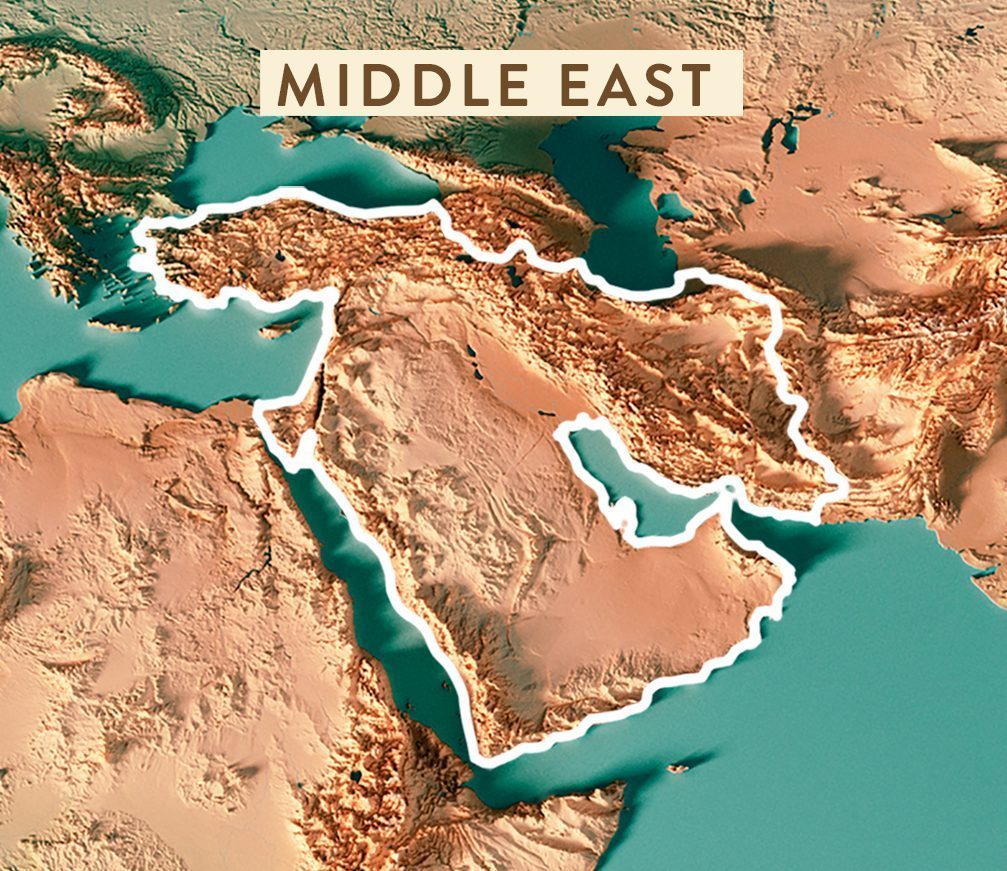CULTIVARS OF THE WORLD
VARIETAL BIODIVERSITY
There are different types of extra virgin olive oil, with countless subtle gradations of flavour and fragrance.
This sensory richness originates from the vast variety of olive cultivars around the world,
which differ in form, physiology and cultivation properties depending on the geographical areas where they are grown,
and which give of their best in different parts of the planet.
Let our passion for oil be your guide to discovering
the unique characteristics of the most widely grown cultivars.

Jordan
In this country olive growing is extremely important and dates back thousands of years. About 15/20% of olive trees are more than 2000 years old, and were mainly introduced under Roman rule. These trees have adapted to the terrain well, even withstanding relatively poor conditions and a desert climate. The oil they produce is of good quality in terms of stability, taste and aroma.
Cultivar of Jordanian origin grown virtually throughout Jordan and Palestine.
Use: dual purpose.
Sensory profile: moderate peppery and fruity components with notes of almond and apple.
Israel
The biblical tradition is rich in episodes that reflect the importance of olive growing: many archaeological finds date olive oil production back at least as far as 6500 years ago. Today olive oil production accounts for about 1% of national agricultural output.
Cultivar of Israeli origin widely grown in the Galilee area and the southern Coastal Plain.
Use: for oil production.
Sensory profile: moderately peppery with a light fruity note, with overtones of peach, lettuce and apple.
Lebanon
In Lebanon, olive output is low. The country's most common cultivar is Soury, from the Arab name of the city of "Sour", by the sea in the south of the country, one of the first ports from which the Phoenicians started their trading operations. Recent studies have shown that primordial Lebanese olive varieties were used and selected to create a large number of varieties grown throughout the Mediterranean basin today.
Cultivar of Lebanese origin widely grown in the Kour and Zgharta zone.
Use: dual purpose.
Sensory profile: moderate peppery and fruity components and light bitter component with flavours of almond and grass.
Cultivar of Lebanese origin widely grown in the north and around Mount Lebanon.
Use: dual purpose.
Sensory profile: moderate-light peppery component with a light fruity note, with flavours of almond and lettuce.
Palestine
This state only achieved productive independence in 2015, so it has only recently joined the world trade in olive oil. However, olive growing dates back several millennia to the bronze age (3550-2000 BC); households were making their own olive oil with small mills as long ago as Roman times.
Cultivar of Palestinian origin widely grown throughout Palestine and Jordan.
Use: for oil production.
Sensory profile: moderate peppery and fruity components with notes of almond and apple.
Syria
Questo Paese si attesta tra i principali produttori olivicoli mondiali. In quest'area viene generalmente individuato l'habitat originario da cui si è generata e diffusa l'originaria Olea europaea. Le cultivar principali, Zaity, Sourani e Doebli, rappresentano più del 90% delle olive coltivate in questo Paese.
Cultivar di origine siriana diffusa nella zona di Masyaf.
Use: da olio.
Sensory profile: caratterizzato da un livello medio di amaro, piccante e fruttato.
Cultivar di origine siriana diffusa nella zona di Banyas e Masyaf.
Use: da olio.
Sensory profile: caratterizzato da un livello medio di fruttato e leggero piccante.
Cultivar di origine siriana diffusa nella zona di Banyas.
Use: da olio.
Sensory profile: caratterizzato da un olio di colore verde molto chiaro, molto delicato, che presenta un livello medio di fruttato e leggero amaro e piccante.
Turkey
Olives have been grown in this country since time immemorial. In recent years, the industry has enjoyed strong Government support: today, Turkey exports olive oil to more than 90 countries worldwide and is aiming to become the world's second biggest producer, with a greater focus on product quality.
Cultivar of Turkish origin which accounts for 19% of the land devoted to olive growing.
Use: for oil production.
Sensory profile: moderate peppery and fruity components and light bitter component with flavours of parsley and artichoke.
Cultivar of Turkish origin widespread in the Aegen and Mediterranean regions.
Use: for oil production.
Sensory profile: moderate peppery and fruity components with flavours of peach and tomato.
Cultivar of Turkish origin also found across the country, from the Mediterranean to the Aegen region and in a number of provinces, including Aydin, Antalya, Büyük, Denizli, Izmir, Kahramanmaras, Kastamonu, Kemalpasa, Manavgat, Manisa, Mugla, Serik, Sinop and Torbali.
Use: for oil production.
Sensory profile: moderate peppery and fruity and light bitter components: flavours of arugola and lettuce.


